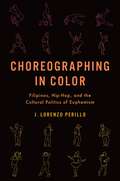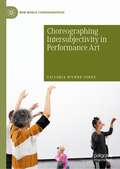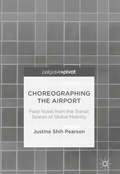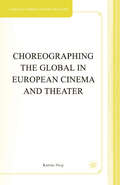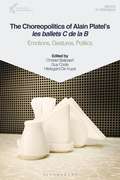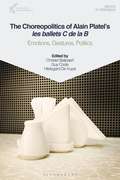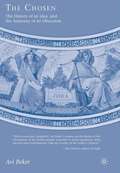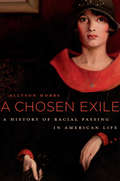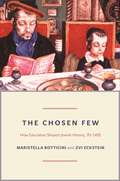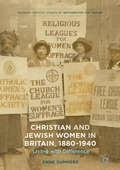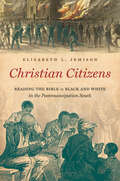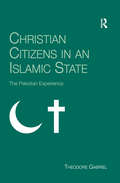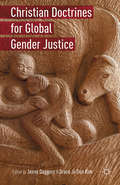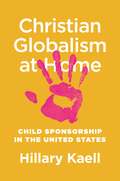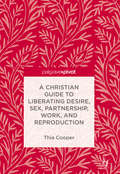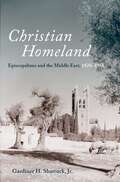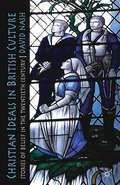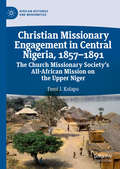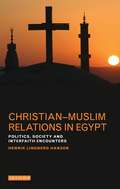- Table View
- List View
CHOREOGRAPHING IN COLOR C: Filipinos, Hip-Hop, and the Cultural Politics of Euphemism
by J. Lorenzo PerilloIn Choreographing in Color , J. Lorenzo Perillo investigates the development of Filipino popular dance and performance since the late 20th century. Drawing from nearly two decades of ethnography, choreographic analysis, and community engagement with artists, choreographers, and organizers, Perillo shifts attention away from the predominant Philippine neoliberal and U.S. imperialist emphasis on Filipinos as superb mimics, heroic migrants, model minorities, subservient wives, and natural dancers and instead asks: what does it mean for Filipinos to navigate the violent forces of empire and neoliberalism with street dance and Hip-Hop? Employing critical race, feminist, and performance studies, Perillo analyzes the conditions of possibility that gave rise to Filipino dance phenomena across viral, migrant, theatrical, competitive, and diplomatic performance in the Philippines and diaspora. Advocating for serious engagements with the dancing body, Perillo rethinks a staple of Hip-Hop's regulation, the "euphemism," as a mode of social critique for understanding how folks have engaged with both racial histories of colonialism and gendered labor migration. Figures of euphemism - the zombie, hero, robot, and judge - constitute a way of seeing Filipino Hip-Hop as contiguous with a multi-racial repertoire of imperial crossing, thus uncovering the ways Black dance intersects Filipino racialization and reframing the ongoing, contested underdog relationship between Filipinos and U.S. global power. Choreographing in Color therefore reveals how the Filipino dancing body has come to be, paradoxically, both globally recognized and indiscernible.
Choreographing Intersubjectivity in Performance Art (New World Choreographies)
by Victoria Wynne-JonesThis book offers new ways of thinking about dance-related artworks that have taken place in galleries, museums and biennales over the past two decades as part of the choreographic turn. It focuses on the concept of intersubjectivity and theorises about what happens when subjects meet within a performance artwork. The resulting relations are crucial to instances of performance art in which embodied subjects engage as spectators, participants and performers in orchestrated art events. Choreographing Intersubjectivity in Performance Art deploys a multi-disciplinary approach across dance choreography and evolving manifestations of performance art. An innovative, overarching concept of choreography sustains the idea that intersubjectivity evolves through places, spaces, performance and spectatorship. Drawing upon international examples, the book introduces readers to performance art from the South Pacific and the complexities of de-colonising choreography. Artists Tino Sehgal, Xavier Le Roy, Jordan Wolfson, Alicia Frankovich and Shigeyuki Kihara are discussed.
Choreographing the Airport: Field Notes from the Transit Spaces of Global Mobility (PDF)
by Justine Shih PearsonThis book investigates the global hub airport as an exemplar of cosmopolitan culture and space. A machine made for movement, itself perched at the crossroads of the world’s incessant mobility, the airport is both a symbol of and stage for the ways in which we construct and inhabit the world today.Taking an ethnographically-inflected approach, this study brings together knowledge of the moving body from dance and performance and the study of systems of mobility within cultural and mobilities studies, in order to call attention to the kinaesthetic experience of global space. What is the choreography of the global airport? How does it perform on us. How do we perform within it?Extending thinking about contemporary cosmopolitanism and cultural identity, and the performativity of places and identities, this book is essential reading for those interested in cultural debates around globalisation, the innovative application of performance theory towards everyday experience, and interdisciplinary methodologies.
Choreographing the Global in European Cinema and Theater (Studies in European Culture and History)
by K. SiegThe book explores European artists' critical engagement with the images and stories that politicians and the media use to advocate globalization.
The Choreopolitics of Alain Platel's les ballets C de la B: Emotions, Gestures, Politics (Dance in Dialogue)
by Christel Stalpaert Guy Cools Hildegard De VuystLes Ballets C de la B was founded by Alain Platel in 1984. Since then it has become a company that enjoys great success at home and abroad. Over the years, Platel has developed a unique choreographic oeuvre. His motto, 'This dance is for the world and the world is for everyone', reveals a deep social and political commitment.Through the three topics of emotions, gestures and politics, this book unravels the choreopolitics of Platel's Les Ballets C de la B. His choreopolitics go beyond conveying a (political) message because rather than defending one opinion, Platel is more concerned about the exposure of the complexity within the debate itself. Highly respected scholars from different fields contribute to this book to provide an interdisciplinary perspective on the intense emotions, the damaged narratives, and the precarious bodies in Platel's choreographic oeuvre.
The Choreopolitics of Alain Platel's les ballets C de la B: Emotions, Gestures, Politics (Dance in Dialogue)
by Christel Stalpaert Guy Cools Hildegard De VuystLes Ballets C de la B was founded by Alain Platel in 1984. Since then it has become a company that enjoys great success at home and abroad. Over the years, Platel has developed a unique choreographic oeuvre. His motto, 'This dance is for the world and the world is for everyone', reveals a deep social and political commitment.Through the three topics of emotions, gestures and politics, this book unravels the choreopolitics of Platel's Les Ballets C de la B. His choreopolitics go beyond conveying a (political) message because rather than defending one opinion, Platel is more concerned about the exposure of the complexity within the debate itself. Highly respected scholars from different fields contribute to this book to provide an interdisciplinary perspective on the intense emotions, the damaged narratives, and the precarious bodies in Platel's choreographic oeuvre.
The Chosen: The History of an Idea, the Anatomy of an Obsession
by A. BekerThe Chosen explores Judaism s key defining concept and inquires why it remains the central unspoken and explosive psychological, historical, and theological problem at the heart of Jewish-Gentile relations. Crisscrossing the twin cultural and theological divides between Judaism, Christendom, and Islam, The Chosen explains how the Jews, of all people, have come to represent at once the epitome of both the good and the odious. Beker covers not only the great stories of how the Jews came to be chosen and the Christian, Muslim, and Nazi efforts to appropriate the title, but also the key role "chosenness" plays in contemporary anti-Semitism and in the current Middle East conflict over the Land of Israel and the chosen city of Jerusalem.
A Chosen Exile: A History of Racial Passing in American Life
by Allyson HobbsCountless African Americans have passed as white, leaving behind families and friends, roots and communities. It was, as Allyson Hobbs writes, a chosen exile. This history of passing explores the possibilities, challenges, and losses that racial indeterminacy presented to men and women living in a country obsessed with racial distinctions.
A Chosen Exile: A History of Racial Passing in American Life
by Allyson HobbsCountless African Americans have passed as white, leaving behind families and friends, roots and communities. It was, as Allyson Hobbs writes, a chosen exile. This history of passing explores the possibilities, challenges, and losses that racial indeterminacy presented to men and women living in a country obsessed with racial distinctions.
The Chosen Few: How Education Shaped Jewish History, 70-1492
by Maristella Botticini Zvi EcksteinIn 70 CE, the Jews were an agrarian and illiterate people living mostly in the Land of Israel and Mesopotamia. By 1492 the Jewish people had become a small group of literate urbanites specializing in crafts, trade, moneylending, and medicine in hundreds of places across the Old World, from Seville to Mangalore. What caused this radical change? The Chosen Few presents a new answer to this question by applying the lens of economic analysis to the key facts of fifteen formative centuries of Jewish history. Maristella Botticini and Zvi Eckstein offer a powerful new explanation of one of the most significant transformations in Jewish history while also providing fresh insights into the growing debate about the social and economic impact of religion.
The Chosen Few: How Education Shaped Jewish History, 70-1492
by Maristella Botticini Zvi EcksteinIn 70 CE, the Jews were an agrarian and illiterate people living mostly in the Land of Israel and Mesopotamia. By 1492 the Jewish people had become a small group of literate urbanites specializing in crafts, trade, moneylending, and medicine in hundreds of places across the Old World, from Seville to Mangalore. What caused this radical change? The Chosen Few presents a new answer to this question by applying the lens of economic analysis to the key facts of fifteen formative centuries of Jewish history. Maristella Botticini and Zvi Eckstein offer a powerful new explanation of one of the most significant transformations in Jewish history while also providing fresh insights into the growing debate about the social and economic impact of religion.
Christian and Jewish Women in Britain, 1880-1940: Living with Difference
by Anne SummersThis book offers an entirely new contribution to the history of multiculturalism in Britain, 1880-1940. It shows how friendship and co-operation between Christian and Jewish women changed lives and, as the Second World War approached, actually saved them. The networks and relationships explored include the thousand-plus women from every district in Manchester who combined to send a letter of sympathy to the Frenchwoman at the heart of the Dreyfus Affair; the religious leagues for women’s suffrage who initiated the first interfaith campaigning movement in British history; the collaborations, often problematic, on refugee relief in the 1930s; the close ties between the founder of Liberal Judaism in Britain, and the wife of the leader of the Labour Party, between the wealthy leader of the Zionist women’s movement and a passionate socialist woman MP. A great variety of sources are thoughtfully interrogated, and concluding remarks address some of the social concerns of the present century.
Christian and Jewish Women in Britain, 1880-1940: Living with Difference
by Anne SummersThis book offers an entirely new contribution to the history of multiculturalism in Britain, 1880-1940. It shows how friendship and co-operation between Christian and Jewish women changed lives and, as the Second World War approached, actually saved them. The networks and relationships explored include the thousand-plus women from every district in Manchester who combined to send a letter of sympathy to the Frenchwoman at the heart of the Dreyfus Affair; the religious leagues for women’s suffrage who initiated the first interfaith campaigning movement in British history; the collaborations, often problematic, on refugee relief in the 1930s; the close ties between the founder of Liberal Judaism in Britain, and the wife of the leader of the Labour Party, between the wealthy leader of the Zionist women’s movement and a passionate socialist woman MP. A great variety of sources are thoughtfully interrogated, and concluding remarks address some of the social concerns of the present century.
Christian Citizens: Reading the Bible in Black and White in the Postemancipation South
by Elizabeth L. JemisonWith emancipation, a long battle for equal citizenship began. Bringing together the histories of religion, race, and the South, Elizabeth L. Jemison shows how southerners, black and white, drew on biblical narratives as the basis for very different political imaginaries during and after Reconstruction. Focusing on everyday Protestants in the Mississippi River Valley, Jemison scours their biblical thinking and religious attitudes toward race. She argues that the evangelical groups that dominated this portion of the South shaped contesting visions of black and white rights. Black evangelicals saw the argument for their identities as Christians and as fully endowed citizens supported by their readings of both the Bible and U.S. law. The Bible, as they saw it, prohibited racial hierarchy, and Amendments 13, 14, and 15 advanced equal rights. Countering this, white evangelicals continued to emphasize a hierarchical paternalistic order that, shorn of earlier justifications for placing whites in charge of blacks, now fell into the defense of an increasingly violent white supremacist social order. They defined aspects of Christian identity so as to suppress black equality—even praying, as Jemison documents, for wisdom in how to deny voting rights to blacks. This religious culture has played into remarkably long-lasting patterns of inequality and segregation.
Christian Citizens in an Islamic State: The Pakistan Experience
by Theodore GabrielChristian Citizens in an Islamic State deals with the important question of inter-faith relations in Pakistan, a vital region of the Islamic world which has been the scene of the rise of both Islamic militancy and partnership with the West in counter-terrorism measures. Christians are the most important religious minority of Pakistan and their status and experience is a test case of the treatment of religious minorities in an Islamic state. This book covers new ground in exploring the various factors that govern the relations between Muslims and Christians in a nation state which has been politically unstable in the past, and where the imposition of Islamic law has been controversial and problematic for religious minorities. Theodore Gabriel clarifies the history of Christian-Muslim relations in the region, explores the rise of Islamic militancy, and draws on personal interviews to determine the mind set of both Christians and Muslims in Pakistan today.
Christian Citizens in an Islamic State: The Pakistan Experience
by Theodore GabrielChristian Citizens in an Islamic State deals with the important question of inter-faith relations in Pakistan, a vital region of the Islamic world which has been the scene of the rise of both Islamic militancy and partnership with the West in counter-terrorism measures. Christians are the most important religious minority of Pakistan and their status and experience is a test case of the treatment of religious minorities in an Islamic state. This book covers new ground in exploring the various factors that govern the relations between Muslims and Christians in a nation state which has been politically unstable in the past, and where the imposition of Islamic law has been controversial and problematic for religious minorities. Theodore Gabriel clarifies the history of Christian-Muslim relations in the region, explores the rise of Islamic militancy, and draws on personal interviews to determine the mind set of both Christians and Muslims in Pakistan today.
Christian Doctrines for Global Gender Justice
by Grace Ji-Sun Kim Jenny DaggersThis book develops creative imagining of traditional doctrines. Chapters show the effectiveness of Latina/mujerista, evangélica, womanist, Asian American, and white feminist imaginings in the furthering of global gender justice.
Christian Globalism at Home: Child Sponsorship in the United States
by Christian Global Hillary KaellAn exploration of how ordinary U.S. Christians create global connections through the multibillion-dollar child sponsorship industryChild sponsorship emerged from nineteenth-century Protestant missions to become one of today’s most profitable private fund-raising tools in organizations including World Vision, Compassion International, and ChildFund. Investigating two centuries of sponsorship and its related practices in American living rooms, churches, and shopping malls, Christian Globalism at Home reveals the myriad ways that Christians who don’t travel outside of the United States cultivate global sensibilities.Kaell traces the movement of money, letters, and images, along with a wide array of sponsorship’s lesser-known embodied and aesthetic techniques, such as playacting, hymn singing, eating, and fasting. She shows how, through this process, U.S. Christians attempt to hone globalism of a particular sort by oscillating between the sensory experiences of a God’s eye view and the intimacy of human relatedness. These global aspirations are buoyed by grand hopes and subject to intractable limitations, since they so often rely on the inequities they claim to redress.Based on extensive interviews, archival research, and fieldwork, Christian Globalism at Home explores how U.S. Christians imagine and experience the world without ever leaving home.
Christian Globalism at Home: Child Sponsorship in the United States
by Christian Global Hillary KaellAn exploration of how ordinary U.S. Christians create global connections through the multibillion-dollar child sponsorship industryChild sponsorship emerged from nineteenth-century Protestant missions to become one of today’s most profitable private fund-raising tools in organizations including World Vision, Compassion International, and ChildFund. Investigating two centuries of sponsorship and its related practices in American living rooms, churches, and shopping malls, Christian Globalism at Home reveals the myriad ways that Christians who don’t travel outside of the United States cultivate global sensibilities.Kaell traces the movement of money, letters, and images, along with a wide array of sponsorship’s lesser-known embodied and aesthetic techniques, such as playacting, hymn singing, eating, and fasting. She shows how, through this process, U.S. Christians attempt to hone globalism of a particular sort by oscillating between the sensory experiences of a God’s eye view and the intimacy of human relatedness. These global aspirations are buoyed by grand hopes and subject to intractable limitations, since they so often rely on the inequities they claim to redress.Based on extensive interviews, archival research, and fieldwork, Christian Globalism at Home explores how U.S. Christians imagine and experience the world without ever leaving home.
A Christian Guide to Liberating Desire, Sex, Partnership, Work, and Reproduction (PDF)
by Thia CooperWhat is good sex from the perspective of liberation theology? Thia Cooper argues that sex can be a way to know God. God created humans with a desire to be in relation with each other. From this understanding, sexual desire, sex, and partnerships are re-imagined positively. Good sex is enjoyable and mutual, an aspect of communion. Good sexual relationships share power, empower the participants, and the wider community. From the perspective of liberation theologies and an analysis of biblical texts, the Christian tradition, and the reality of our sexual experience, this book reframes theologies of partnership, sex work, and reproduction through the celebration of desire and sex.
Christian Homeland: Episcopalians and the Middle East, 1820-1958
by Gardiner H. Shattuck, Jr.Christian Homeland focuses on the involvement of clergy and prominent laity of the Episcopal Church in Middle Eastern affairs, both religious and political, between the Greek War of Independence (1821-1829) and the Second Arab-Israeli War (1956-1957), with a brief epilogue covering additional events up to the present day. As the birthplace of the Christian faith, the Middle East had always been an area of fascination to church people in the West, and with the expansion of American diplomatic and commercial interests into the Mediterranean in the early nineteenth century, Episcopalians and other American Protestants felt called to similarly export their religious values into the region. Beginning in the 1830s, Episcopalians established mission posts in Athens and Constantinople (Istanbul), from which they sought to convert Muslims and Jews to Christianity. Having failed to achieve any appreciable evangelistic success with non-Christians, they soon turned their attention to reforming the ancient churches of the East instead. Later assisted by the Church of England's missionary bishopric in Jerusalem, a small, but influential corps of Episcopalians dedicated themselves to keeping church members informed about the Middle East, particularly the status of the region's Christian population, well into the twentieth century. This book analyses how the theological ideas held by Episcopal church leaders not only guided missionary and religious activities, but also influenced their denomination's response to major social and political questions of the late nineteenth and early twentieth centuries issues such as immigration into the United States, genocide, wartime refugee relief, anti-Semitism, Zionism, and the Palestinian Nakba.
Christian Homeland: Episcopalians and the Middle East, 1820-1958
by Gardiner H. Shattuck, Jr.Christian Homeland focuses on the involvement of clergy and prominent laity of the Episcopal Church in Middle Eastern affairs, both religious and political, between the Greek War of Independence (1821-1829) and the Second Arab-Israeli War (1956-1957), with a brief epilogue covering additional events up to the present day. As the birthplace of the Christian faith, the Middle East had always been an area of fascination to church people in the West, and with the expansion of American diplomatic and commercial interests into the Mediterranean in the early nineteenth century, Episcopalians and other American Protestants felt called to similarly export their religious values into the region. Beginning in the 1830s, Episcopalians established mission posts in Athens and Constantinople (Istanbul), from which they sought to convert Muslims and Jews to Christianity. Having failed to achieve any appreciable evangelistic success with non-Christians, they soon turned their attention to reforming the ancient churches of the East instead. Later assisted by the Church of England's missionary bishopric in Jerusalem, a small, but influential corps of Episcopalians dedicated themselves to keeping church members informed about the Middle East, particularly the status of the region's Christian population, well into the twentieth century. This book analyses how the theological ideas held by Episcopal church leaders not only guided missionary and religious activities, but also influenced their denomination's response to major social and political questions of the late nineteenth and early twentieth centuries issues such as immigration into the United States, genocide, wartime refugee relief, anti-Semitism, Zionism, and the Palestinian Nakba.
Christian Ideals in British Culture: Stories of Belief in the Twentieth Century
by D. NashThis book offers a challenge to conventional histories of secularisation by focusing upon the importance of central religious narratives. These narratives are changed significantly over time, but also to have been invested with importance and meaning by religious individuals and organisations as well as by secular ones.
Christian Missionary Engagement in Central Nigeria, 1857–1891: The Church Missionary Society's All-African Mission on the Upper Niger (African Histories and Modernities)
by Femi J. KolapoIn the decades before colonial partition in Africa, the Church Missionary Society embarked on the first serious effort to evangelize in an independent Muslim state. Bishop Samuel Ajayi Crowther led an all-African field staff to convert the people of the Upper Niger and Confluence area, whose communities were threatened or already conquered by an expanding jihadist Nupe state. In this book, Femi J. Kolapo examines the significance of the mission as an African—rather than European—undertaking, assessing its impact on missionary practice, local engagement, and Christian conversion prospects. By offering a fuller history of this overlooked mission in the history of Christianity in Nigeria, this book reaffirms indigenous agency and rethinks the mission as an experiment ahead of its time.
Christian-Muslim Relations in Egypt: Politics, Society and Interfaith Encounters (Library of Modern Religion)
by Henrik Lindberg Hansenhe subject of Christian-Muslim relations in the Middle East – and indeed in the West – attracts much academic and media attention. Nowhere is this more the case than in Egypt, which has the largest Christian community in the Middle East, estimated at 6-10 per cent of the national population. Henrik Lindberg Hansen analyses this relationship, offering an examination of the nature and role of religious dialogue in Egyptian society. Taking three main religious organizations and institutions in Egypt (namely the Azhar University, the Muslim Brotherhood and the Coptic Orthodox Church), Hansen argues that religious dialogue involves a close examination of societal relations, and how these are understood and approached. Including analysis of the occasions of violence against Christian communities in 2011 and the fall of the Muslim Brotherhood from power in 2013, Hansen provides a wide-ranging exploration of the importance of religion in Egyptian society and everyday encounters with a religious 'other'. This makes his book vital for researchers of both religious minorities in the Middle East and interfaith dialogue in a wider context.
